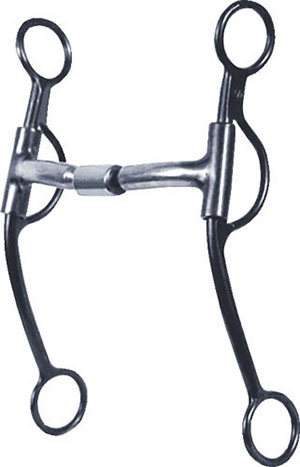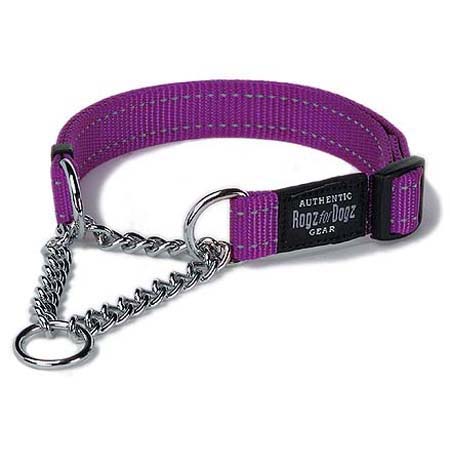This post is more of a multiple purpose post. While the main topic is bad riding/riders, I will be discussing bad equipment, better/worse equipment and overall a few more topics, as they come into my mind.
I’m not going to mention any peoples names. They’re just going to go as anonymous. To begin with is rollkur. For those of you who are not familiar with rollkur, it’s very common in dressage, more like the main thing in dressage.
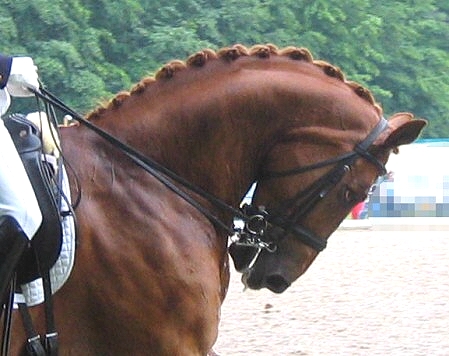
A horse in extreme rollkur. Note the extremely tight reins, and the horse is gaping to try and relax the extreme pain. You can almost see the pain in his eyes.
The other name for rollkur is hyperflexion. It is not uncommon for the horse to foam excessively at the mouth when ridden under rollkur. That is because it is extremely unnatural for horses to hold their head and neck in such a position. Many horses tongues have been witnessed going blue and dangling out of their mouth due to lack of blood supply. Why? Because the rider is pulling the reins too hard. That is the only way one hold the horses head like that. Refer to the above image, and see how tight the reins are. Remember, the horses’ tongue is always under the bit. To pull a horses’ head down with the bit that is over his tongue, and to hold it there, applies so much pressure on the tongue to cut the blood supply to the tongue.

Note the horses’ tongue is blue and limply hangs out of his mouth. However, the contact seems light to his mouth in the picture. But the horse is in extreme rollkur, and that is proof that his tongue was blue due to the pressure.
FACT:
A horse tongue cannot go blue with a two piece mouthpiece. Why? Because to get the rollkur, normally pulling your reins back will not get the desired result. Sure, the horse will pull his head back, but not down, as in rollkur. To get rollkur, you push the reins down, to their shoulder, and then pull back and down. That’s what will get the horses neck in that ‘desired’ position. To hold it, you’ll have to pull the reins upwards, though. Now, under normal conditions, if you pulled back, the jointed mouthpiece will become like this: >, with the point to the outside of his mouth. That will cause it to pinch the mouths’ side, therefore it has a ‘nutcracker’ effect. But back to getting it to rollkur, the bit will become something like this: ^, with the point hitting the horse on the roof of his mouth. Obviously, it hurts, but the tongue has no direct pressure on it, therefore it can’t turn blue. Please note that the < and ^ symbols don’t represent what the bit will look like in reality; it is just the closest symbol to enter for now.
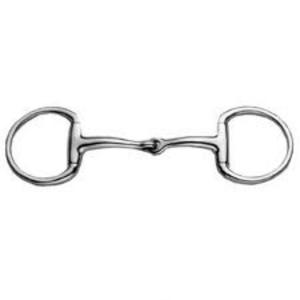
A two-piece snaffle, for you to get an idea of the nutcracker effect and how the tongue has no direct pressure.
A two piece is also alternatively called the single jointed mouthpiece.
Another thing, three-piece or double jointed bits have very little nutcracker effect if any at all. While the image attached below shows the bit as crooked, which would mean a nutcracker effect, it does not happen in the horses’ mouth, unless the bit is so long it the joint takes almost the entire of the horse mouth, which is obviously impossible. If you pull it to get rollkur even, the centre joint lifts off of its tongue, which has a very little nutcracker effect, but it can’t become a point, unlike the two piece because the centre joint holds the two main pieces. That applies the pressure on the bars, as it should. It keeps the sensitive tongue from getting the pressure. Note that under normal circumstances(that is, not asking for rollkur) the bit will have slight nutcracker if pulled on hard.
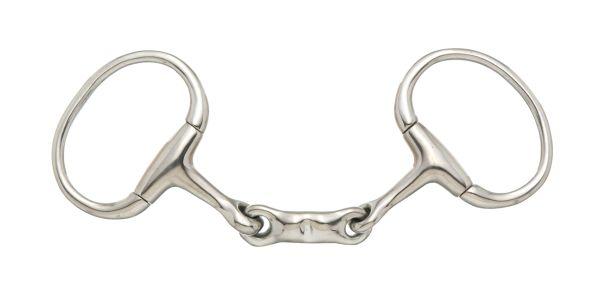
A three-piece snaffle bit. You can get an idea of how the centre piece does not let the bit become a point.
Now, DO NOT think I’m targeting dressage for the bad riding part. Next, I’d like to discuss cross country. Sure, XC may seem more natural for the horse, instead of jumping upright fences in SJ(Show Jumping), they’re jumping logs in a seemingly natural setting, it can be harder on the horse. Firstly, most cross country jumps nowadays are bigger than the horse itself. If not, they’re kinda tough for the horse. Sure, if they’re small, go for it! What I’m targeting here are the high/big jumps.
It stresses the horses’ fetlocks for landing from such high fences, and while it may remain true that if the jump is wider it reduces the landing force, it still doesn’t omit it completely. The chances of serious injury are higher in XC, because if the horse has a tiny miscalculation, and either jumped too early, too late or knocked the jump, the jump does not move. That can easily cause the horse to flip over, break his neck, feet, anything and it can be fatal for the rider as well, as opposed to SJ where the jump will fall if the horse knocks it. To sum it all up, that’s not natural for the horse. If the sizes are small, then you’re well off.
Now, for some more topics.
Firstly is the common ‘misconception’ that the bit can affect how the rider communicates to the horse, and while that is somewhat true, it really is the rider who controls how he communicates with the horse. For example, some curbs have quite a bad reputation for having lots of leverage, while in fact with a very soft hand, they’re quite as good as a snaffle. And some snaffles have an incredibly good reputation for being very soft to the horses’ mouth, while a hard and rough hand can cause as much damage as the above-mentioned curb bits. So what I’m trying to get at is that if the rider uses the bit properly then the ‘worst’ can be the best and the ‘best’ can be the worse. Remember, the bit is an aid; an aid to the riders’ hands. If used properly, they’re great, but otherwise, they’re simply the worst. Take, for example, a car. A car is a tool. You can use the same tool to do bad things and good things alike. The same with a bit of any sort. You can use gently and be good to the horse’s mouth or use it roughly and be bad to it. (The reason misconception is in inverted commas is because it usually is pretty obvious that the bit is a tool. Many people genuinely believe that the bit affects the communication, those people are educated the wrong way. And if the trainer who told him/her that claimed he/she was fully qualified, I would never believe that person.)
Secondly is the use of spurs. For those of my readers who are unfamiliar with spurs, they’re an extension of the leg of the rider, more frequently called a leg aid, as they are an aid to one’s leg. Whether you decide to call it a leg aid, a leg extension or anything else, a brief description of most types of spurs would be a metal thing that drives deep into the tummy of the poor horse when the weak little rider kicks or squeezes. However, a few types of spurs don’t fit into that description, such as bumper spurs and ball spurs. Some people believe that English spurs are gentler and Western spurs hurt the horse a lot more. However, in simple terms, English or Western doesn’t make a difference in spurs. Some types of Western spurs are not that harsh and some English are terribly harsh. The basic idea is that discipline does not matter for spurs. Ball or roller spurs are used in Western and English and not particularly bad, and so are bumper spurs, even though both are more commonly seen in English. But why have I put using spurs in this post? Because of the ones with lots of spikes. Most of those ones even have blades. Those are the bad types. But as I mentioned with bits too, spurs are just an aid. The way one uses the spurs can change how the spur behaves. If you ram a bumper spur repeatedly into the horse, they’ll hurt him also, even if otherwise they’re ‘gentle’.
Okay, that’s it for this post. I know it is quite a long read, but I’m pretty sure it’s not boring. By now, you’re probably boiling with rage against me and disagreeing with me, or else you’re very enthusiastic and agreeing with me. Whatever the case is, comment your thoughts below. See ya next time, I’ve got two more posts in pipeline already 🙂
P.S. How do you like my blogs’ new theme?

